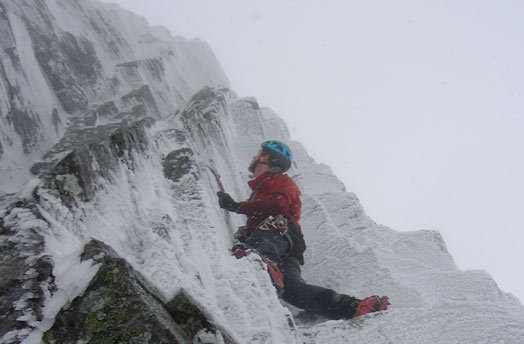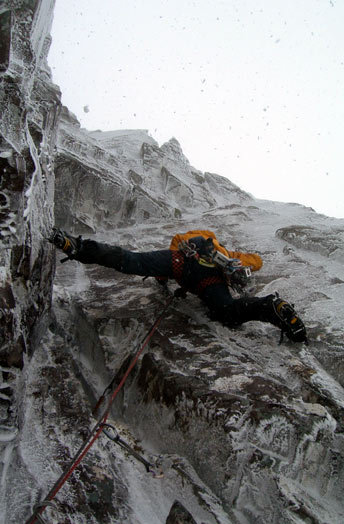
Steve Ashworth on the third pitch of Knuckleduster (VIII 9, 120m, 4 pitches), Ben Nevis (1343m), Scotland. Ashworth and Blair Fyffe made the first ascent of this line, one of the mountain’s many new mixed routes, on February 12. Just above this point, Ashworth took an eight-meter fall that ripped out a wire and sent him crashing into a ledge. Luckily, he managed to keep hold of his leashless axes. [Photo] Blair Fyffe / Highland Guides
On February 12, Steve Ashworth and I made the first winter ascent of Knuckleduster (120m, 4 pitches) on Ben Nevis (1343m), Scotland at VIII 9. Although not very large by world standards, Ben Nevis is a mountain steeped in history with a reputation for wild weather and bold routes. In the summer Knuckleduster takes the huge groove line up the center of Number Three Gully Buttress and was first climbed by the infamous Marshall brothers in 1966. In warmer weather it goes at a moderate HVS 5a, but due to its position high on the mountain, and the fact that it is slow drying, it has never gained popularity as a summer route. In winter, however, it has become a coveted line as increasingly difficult mixed routes gain popularity.
Over the past three winter seasons, two other summer routes (Sioux Wall and Arthur) of the same grade, HVS 5a, have received winter ascents at grade VIII. Knuckleduster was the next obvious target, but multiple strong parties have been forced to retreat due to its steep and sustained terrain. During one attempt in the winter of 2003-04, Bruce Poll fell off the second (crux) pitch, ripping out old in-situ gear and ending up hanging unconscious below his belayer with numerous broken bones.
The temperature was just above 0 degrees C on February 12, and a thick, damp mist reduced visibility and soaked our clothing and equipment. Despite the warm weather, the winter conditions on-route were good: a dribble of ice plastered the back of the groove and rime covered the rocks. The first pitch was steeper and trickier than it appeared from below. A little way up the second pitch a large roof forced me to traverse right out of the groove onto a vertical wall. It steepened significantly above the wall, and this section proved to be the crux. Steep moves, with little for the feet, allowed me to grab an obvious flake. It felt loose, but I had no option but to haul on it. Luckily it held. A long reach allowed placements onto a foot wide, overhanging belay ledge. We diverged from the summer route to enter a steep and tricky smaller groove for the next pitch. A little way up this pitch Steve took an unexpected fall, ripping his top wire and colliding with a ledge. Luckily he held onto his leashless tools and was able to return up the groove in pain. Our equipment began to freeze up as night set in. Above Steve’s pitch a thirty-meter blank, steep wall stymied us until we found a delicate traverse right that took us to a wide crack. This led to easier ground, which we followed to the summit plateau.

Blair Fyffe leading the second (crux) pitch on the first winter ascent of Knuckleduster (VIII 9, 120m, 4 pitches), Ben Nevis (1343m), Scotland. On a previous winter attempt the leader fell below the belay, breaking bones and going unconscious. [Photo] Steve Ashworth
It felt good to get the first winter ascent of such an obvious and independent line as this one. Climbers have finally begun exploiting the massive potential for mixed climbing on Ben Nevis, which traditionally has been an ice venue. If we had not climbed it, I am sure that one of the very strong teams attending the BMC (British Mountaineering Council) 2007 International Winter Meet, which was held in late February, would have given it a go; as it was, at least five new routes were added to the mountain during the Meet. Hopefully the obvious, challenging line of Knuckleduster will become one of many future classics.